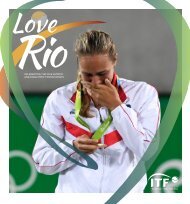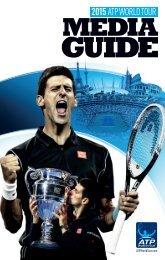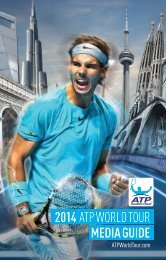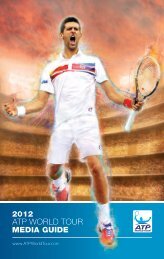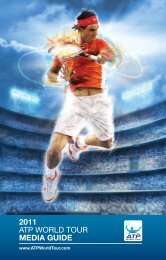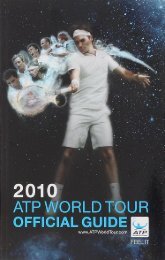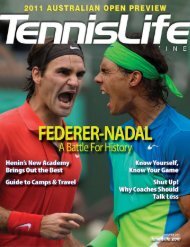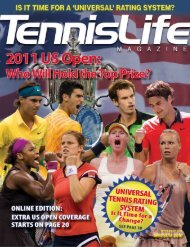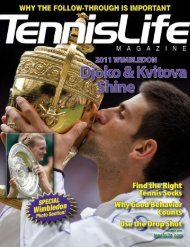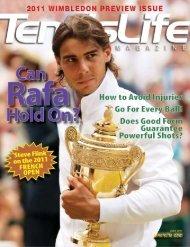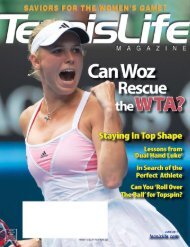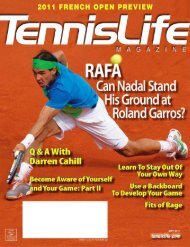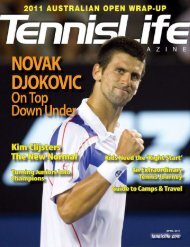A Champion's Mind - Pete Sampras
www.tennismoscow.me Insta:TENNISMOSCOW
www.tennismoscow.me Insta:TENNISMOSCOW
You also want an ePaper? Increase the reach of your titles
YUMPU automatically turns print PDFs into web optimized ePapers that Google loves.
me. It didn’t hurt that the shorts were a striking contrast to the gear Nike created for Andre. Who can<br />
forget those black shorts with the fluorescent pink compression shorts underneath?<br />
Over the years, I hit rough patches with Nike and often felt that the company didn’t do very much to<br />
market me, especially in contrast to Andre. But Nike did its best to capitalize on our rivalry. One of my<br />
few off-court run-ins with Andre was engineered by Nike. In 1993, Nike had this exhibition before the<br />
French Open, and Phil Knight (the founder and then CEO of Nike) got together with a few clients,<br />
including Jim Courier, John McEnroe, and Andre. Phil told them that he wanted to stir up a little<br />
controversy. Andre, who was in that period when he frequently said provocative things, obliged Phil. He<br />
said of my rise to number one, “Nobody should be ranked number one who looks like he just swung from<br />
a tree.”<br />
The comment became public overnight, and when it was brought to me I refused to rise to the bait. I<br />
shrugged. Andre could say what he wanted, it made no difference to me. So the ploy kind of backfired,<br />
and it left Andre feeling uneasy. He wrote me a nice fax a few days later, apologizing for the remark and<br />
telling me how much he respected my game.<br />
Because Andre was so flamboyant, he seemed to get an inordinate amount of Nike’s attention. Once, in<br />
a fit of pique, I told one of Nike’s top executives, “Listen, I’m not one to cry much, or complain. I’m a<br />
quiet guy. But I’ve had my moments—in Australia with Jim Courier, in Flushing Meadows with Alex<br />
Corretja, getting sick and all that . . . those weren’t moments I created or set up to make myself look a<br />
certain way. I’m not doing any of this on purpose, or to project an image other than what I am. So what<br />
more do you want from me, as an athlete? You tell me Nike is all about performance, so what more can I<br />
do?”<br />
However, one of the good things about all the exposure and attention Andre got was that it took<br />
pressure off me. I was content to operate outside the limelight as much as I could. The difference between<br />
us that way also helped keep the rivalry from becoming too intense, which was a real danger because,<br />
unlike, say, Roger Federer and Rafael Nadal, we were from the same country. All in all, I think we did a<br />
great job over our careers of keeping things under control. We had no public feuds. It was a dignified<br />
rivalry, with very little trash talking. The truth is that even though one or the other of us might get in a little<br />
snit from time to time, we basically liked each other.<br />
The best expression of our commonality was in the most successful commercial exploitation of our<br />
rivalry—that wildly successful “guerrilla tennis” television ad campaign of 1995. That was a series of<br />
commercials in which Andre and I jumped out of vehicles in unlikely urban locations to set up a net and<br />
play tennis before astonished passers-by. It was drive-by tennis before “drive-by” was part of our<br />
vocabulary.<br />
The campaign was brilliant, and it was an enormous success. And it worked because, instead of “<strong>Pete</strong><br />
or Andre?” or “<strong>Pete</strong> vs. Andre” driving Nike’s promotions, it became <strong>Pete</strong> and Andre. There was a<br />
welcome, counterintuitive feel-good message conveyed in them. The commercials helped further interest<br />
in the game and our rivalry. It also caught the true nature of our relationship. We had plenty of differences,<br />
but we were friends.<br />
Much later that year, after the U.S. Open and the Las Vegas Davis Cup tie against Sweden, Andre<br />
invited me to fly with him on his private jet on a trip to Los Angeles. Andre was on the cusp of that long<br />
slide into the depths of the rankings, brought on by my win over him in the U.S. Open final of ’95. (He<br />
bottomed out at number 141 in the fall of 1997, setting the stage for an equally remarkable resurgence.)<br />
I sensed on that flight that Andre was struggling. He quizzed me very closely on how I lived my life,<br />
and seemed dumbfounded to learn that I had moved to Tampa solely for my tennis game. I told him that I<br />
missed my family, and Southern California, but considered it a necessary trade-off. He admitted that he<br />
wouldn’t give up living in Vegas, or his lifestyle, in order to be the best player in the world. The contrast<br />
was clear and striking, although Andre made that point at a time when he was feeling a little disillusioned



